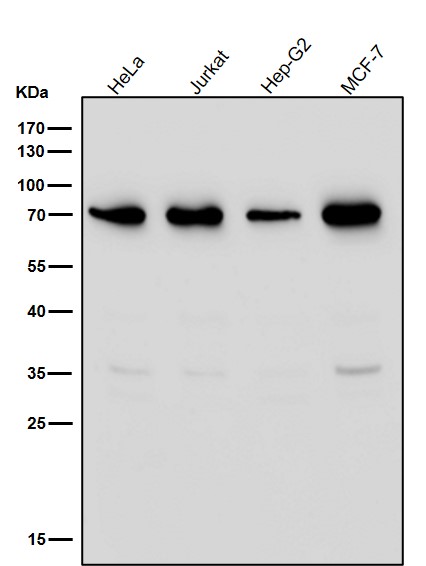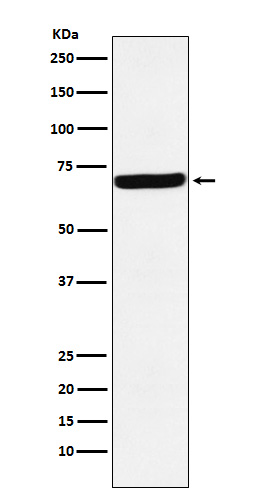

| WB | 咨询技术 | Human,Mouse,Rat |
| IF | 1/20-1/50 | Human,Mouse,Rat |
| IHC | IHC:1/100-1/200;IHF:1/50-1/200 | Human,Mouse,Rat |
| ICC | 1/50-1/200 | Human,Mouse,Rat |
| FCM | 1/20-1/100 | Human,Mouse,Rat |
| Elisa | 咨询技术 | Human,Mouse,Rat |
| Aliases | G3BP; G3bp1; hDH VIII;;G3BP1 |
| WB Predicted band size | Calculated MW: 52 kDa ; Observed MW: 68 kDa |
| Host/Isotype | Rabbit IgG |
| Antibody Type | Primary antibody |
| Storage | Store at 4°C short term. Aliquot and store at -20°C long term. Avoid freeze/thaw cycles. |
| Species Reactivity | Human,Mouse,Rat |
| Immunogen | A synthesized peptide derived from human G3BP1 |
| Formulation | Purified antibody in PBS with 0.05% sodium azide,0.05% BSA and 50% glycerol. |
+ +
以下是关于G3BP抗体的3篇代表性文献摘要概括:
---
1. **文献名称**:*The RasGAP-associated endoribonuclease G3BP assembles stress granules*
**作者**:Tourrière, H. 等 (2003. *J Cell Biol*)
**摘要**:研究揭示G3BP1通过其RNA结合功能调控应激颗粒(SGs)的形成,并发现其与去泛素化酶USP10的相互作用。实验使用G3BP抗体通过免疫荧光验证其在应激条件下(如氧化应激)的颗粒聚集,证实G3BP1是SGs的核心组分。
2. **文献名称**:*G3BP1 is a key regulator of stress granule dynamics*
**作者**:Kedersha, N. 等 (2016. *Cell Reports*)
**摘要**:通过敲除和抗体标记实验,证明G3BP1对SGs的组装和分解至关重要。研究发现G3BP1与TIA-1协同作用,其抗体在亚细胞定位分析中显示,G3BP1缺失显著抑制SGs形成,提示其在细胞应激反应中的主导作用。
3. **文献名称**:*Targeting of viral RNAs by upregulation of G3BP during infection*
**作者**:Reineke, L.C. 等 (2015. *Nat Commun*)
**摘要**:利用G3BP抗体探究病毒感染(如丙型肝炎病毒)对SGs的调控机制,发现病毒通过降解G3BP1破坏宿主抗病毒应激颗粒。免疫印迹和共聚焦显微术显示G3BP1表达动态变化与病毒复制周期相关。
---
以上研究均依赖G3BP抗体进行蛋白定位、表达水平或功能验证,涉及应激反应、病毒-宿主互作等领域。具体抗体信息需参考各文献方法部分(如货号、厂商)。
G3BP antibodies target the Ras GTPase-activating protein-binding protein (G3BP) family, comprising G3BP1 and G3BP2. which are multifunctional RNA-binding proteins involved in stress granule (SG) formation, RNA metabolism, and cellular stress responses. These proteins contain conserved domains, including an N-terminal nuclear transport factor 2 (NTF2)-like domain, an RNA recognition motif (RRM), and acidic and proline-rich regions, enabling interactions with RNAs, proteins, and signaling molecules. G3BP1. the better-characterized isoform, acts as a scaffold for SGs—dynamic cytoplasmic aggregates formed during stress to sequester untranslated mRNAs and regulate translation. It also modulates Ras signaling, antiviral immunity, and cell proliferation.
G3BP antibodies are widely used to study SG dynamics, particularly in neurodegenerative diseases (e.g., ALS, Alzheimer’s) and cancer, where dysregulated SG assembly correlates with pathology. They enable detection of G3BP expression/localization via techniques like Western blotting, immunofluorescence, and immunoprecipitation. Some viruses exploit G3BP to disrupt SGs, facilitating replication, making these antibodies valuable in virology research. Additionally, G3BP antibodies help investigate post-translational modifications (e.g., phosphorylation) that regulate its functions. Their specificity varies; some distinguish G3BP1 from G3BP2. while others cross-react. Overall, G3BP antibodies are critical tools for exploring cellular stress adaptation, RNA biology, and disease mechanisms.
×